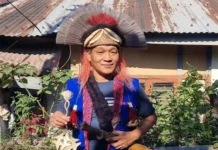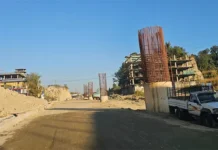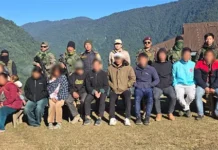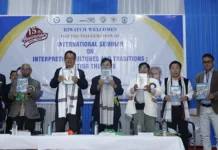[ Kina Kangnong ]
The Ollos, who live and shelter in the hills and valleys of the Patkai range of Tirap district, along the Indo-Myanmar border, languish in the shadow of opium – a crop that binds their livelihoods yet chains their future.
This isolated region – among the state’s most backward in economy, literacy, infrastructure, and political influence – teeters on the edge of ruin, not solely from its illicit harvest but from the deeper malaise of inaccessibility. As India strides toward progress, the Ollos’ plight underscores a stark truth: without proper roads, bridges, and pathways to opportunity, development remains a distant dream.
To make the situation worse, there is the infamous longtung (huge landslide) between Tirap HQ Khonsa and Lazu that activates almost every monsoon, disrupting the already weak transportation system. Yet, as the Centre and the state push for a drug-free society, the path to liberating the region from opium’s grip lies not in force but in fostering accessibility and alternative futures.
The Ollos’ stagnation stems from two intertwined failures. First, decades of government neglect since independence have left the region stranded. Locals allege a lack of political representation has muted their voice, leaving Tirap – and Ollo specifically – overlooked in development plans. The result is glaring: treacherous roads, absent bridges, and rugged terrain isolate the Ollos, choking their potential. Inaccessibility isn’t just an inconvenience; it’s a death knell for progress, ensuring that the Ollos lag in every sphere of development.
Accessibility is the cornerstone of any region’s growth, and its absence in Ollo-inhabited areas is a study in deprivation. Economically, reliable roads and transport networks are lifelines, enabling farmers to reach markets and businesses to scale. In Ollo-inhabited areas, where fertile hills could yield high-value produce, the lack of all-weather roads stifles this promise.
Education and healthcare suffer equally. With literacy rates in Tirap below 50%, inaccessible schools deter teachers and students alike, perpetuating illiteracy. Health crises turn fatal when ambulances can’t navigate muddy tracks. Politically, inaccessibility breeds disenfranchisement, with low voter turnout and unheard grievances feeding a cycle of neglect. Conversely, robust infrastructure invites tourism, showcasing the Ollos’ Woraang festival and bamboo crafts, preserving culture while generating revenue.
Yet, inaccessibility is only half the story. Opium, illegal yet intrinsic to the Ollos’ culture, is the community’s sole economic anchor. Passed down through generations, its cultivation funds education, marriages, and survival itself. Students in far-off hostels rely on poppy profits, a grim irony as the government’s campaigns against narcotics intensify. The Ollo people, largely illiterate and leaderless, now fear these crackdowns, knowing opium is their only income source. Heavy-handed enforcement, as seen elsewhere in the Northeast, risks alienating them further, driving the trade underground rather than ending it.
Suppression may clear fields but sows resentment, not reform. The way forward demands empathy over force, weaving accessibility with opportunity.
First, cooperative agreements between government agencies and the Ollo people can uproot opium sustainably. Dialogues, facilitated by elders and groups like the All Ollo Welfare Association (AOWA), could set timelines for voluntary crop surrender with amnesty, building trust and minimizing the trust gap, which is widening due to harsh and forceful implementation of law.
Second, alternative agriculture is key. The Ollos’ climate suits high-value crops like ginger, large-cardamom, or pineapples, which promise quicker returns than poppies and bolster state exports, aligning with India’s Atmanirbhar Bharat vision. However, seeds alone won’t suffice. Awareness campaigns – via mobile vans, local radio, or self-help groups – must spotlight schemes like PM-KISAN, MGNREGA, and Rashtriya Krishi Vikas Yojana, which remain unknown to most Ollo farmers.
Third, training is non-negotiable. Without knowledge of sowing seasons, pest control, or harvesting, new crops will fail. Government agencies and the Agriculture Department can deploy extension services to transform Ollo youth into skilled organic farmers. Many farmers fear shifting to new crops and practices, are sceptical of profit, and fear losses.
Finally, systemic inclusion is vital. Talks between district authorities, the police, AOWA, and student representatives should craft binding commitments. Given the Ollos’ acute backwardness, affirmative measures – job reservations, education quotas, or procurement preferences for local produce – would signal genuine upliftment, not charity.
Unemployment has shackled Ollo youths and is slowly dragging them into a vicious cycle of poverty. The government must intervene and take necessary steps and initiatives to break the chain that shackles the youths and the Ollo community at the right time, and the right time is now.
As Arunachal’s Vision 2047 takes shape, the Ollo community stands at a crossroads: deeper entrenchment in opium’s shadow or a leap towards prosperity through accessibility. Roads will carry more than goods; they’ll bring schools, clinics, and voices to the fore. Opium may be the community’s past, but with bridges built and mindsets shifted, its future could bloom with promise. The Centre and state must act not as enforcers but as partners, ensuring that the Ollo community’s fields grow hope, not despair. (The contributor is pursuing MA in geography at the Banaras Hindu University)




